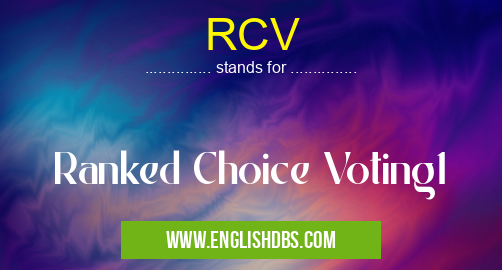What does RCV mean in UNCLASSIFIED
RCV, or Ranked Choice Voting, is an electoral system that allows voters to rank candidates in order of preference. This system is designed to ensure that the winning candidate has the support of a majority of voters.

RCV meaning in Unclassified in Miscellaneous
RCV mostly used in an acronym Unclassified in Category Miscellaneous that means Ranked Choice Voting1
Shorthand: RCV,
Full Form: Ranked Choice Voting1
For more information of "Ranked Choice Voting1", see the section below.
How RCV Works
Voters rank candidates on their ballot in order of preference, from their first choice to their last. Instead of choosing only one candidate, voters can rank as many or as few candidates as they wish.
During the first round of counting, the first-choice votes are tallied. If a candidate receives a majority of the first-choice votes, they are declared the winner. If no candidate receives a majority, the candidate with the fewest first-choice votes is eliminated.
The ballots of the eliminated candidate are then redistributed to the second-choice candidates. The second-choice votes are then tallied, and the process is repeated until a candidate receives a majority of the votes.
Advantages of RCV
- Reduces the likelihood of spoiler candidates: RCV prevents candidates from winning with a plurality of votes, even if they do not have the support of a majority of voters.
- Encourages positive campaigning: Candidates are less likely to engage in negative campaigning if they know that voters can rank multiple candidates.
- Represents voter preferences more accurately: RCV allows voters to express their preferences more fully by ranking candidates.
- Promotes consensus: RCV can help to build consensus by ensuring that the winning candidate has the support of a majority of voters.
Disadvantages of RCV
- Can be more complex to understand: RCV can be more complex to understand than traditional voting systems.
- Can lead to multiple rounds of counting: In some cases, RCV can lead to multiple rounds of counting, which can be time-consuming.
- Can be difficult to implement: RCV requires changes to voting systems and processes, which can be difficult to implement in some jurisdictions.
Essential Questions and Answers on Ranked Choice Voting1 in "MISCELLANEOUS»UNFILED"
What is Ranked Choice Voting (RCV)?
RCV is an electoral system that allows voters to rank candidates in order of preference. Voters rank candidates from their most-preferred to least-preferred. The candidate with the most first-place votes wins, even if they do not receive a majority of the votes. If no candidate receives a majority of first-place votes, the candidate with the fewest first-place votes is eliminated, and the voters' second-place votes are counted. This process continues until one candidate wins a majority of the votes.
How does RCV differ from traditional voting systems?
In traditional voting systems, voters select only one candidate. In RCV, voters can rank multiple candidates. This allows voters to express their preferences more accurately and reduces the likelihood of a candidate winning with a minority of the votes.
What are the benefits of RCV?
RCV has several benefits over traditional voting systems, including:
- Increased voter satisfaction: Voters can rank candidates in order of preference, ensuring that their vote reflects their true preferences.
- Reduced negative campaigning: Candidates are less likely to engage in negative campaigning because they know that voters can rank multiple candidates.
- Greater representation: RCV can help elect candidates who represent a broader range of voters, as it reduces the likelihood of a candidate winning with a minority of the votes.
What are the drawbacks of RCV?
RCV has a few drawbacks, including:
- Increased complexity: RCV can be more complex to understand and implement than traditional voting systems.
- Potential for confusion: Voters may be confused by the process of ranking candidates, which could lead to errors in voting.
- Potential for manipulation: Some argue that RCV could be manipulated by strategic voting, where voters rank candidates in a way that maximizes their chance of electing a particular candidate.
Is RCV used in any elections?
Yes, RCV is used in a growing number of elections around the world. In the United States, RCV is used in several cities, including San Francisco, Oakland, and Minneapolis.
Final Words: RCV is an electoral system that has the potential to improve the fairness and representativeness of elections. However, it is important to weigh the advantages and disadvantages of RCV before implementing it in a particular jurisdiction.
